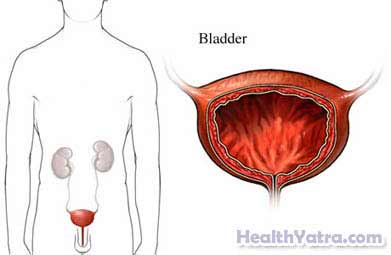সংজ্ঞা
Interstitial cystitis is chronic inflammation of the wall of the bladder. Inflammation can cause scarring and/or pinpoint bleeding of the bladder wall. It can also lead to decreased space to hold urine.

কারণসমূহ
Although the symptoms are similar to those of a bladder infection, there is usually no clear cause. Bacteria, fungi, and/or viruses are rarely found in the urine of people with interstitial cystitis. Possible causes include:
- An autoimmune response that occurs following a bacterial infection of the bladder
- A leaky inner lining of the bladder that allows irritating substances in the urine to come into contact with the bladder wall
ঝুঁকির কারণ
Interstitial cystitis is more common in women and Caucasians. Other factors that may increase your chance of getting interstitial cystitis include:
- History of urinary tract infections
- Irritable bowel syndrome
- Associated pain disorders, such as fibromyalgia or chronic fatigue syndrome
লক্ষণ
The symptoms of interstitial cystitis vary from person to person. They can also occur in cycles. Symptoms may include:
- Urgent need to urinate.
- Frequent need to urinate several times a day.
- Discomfort, pain, or pressure in the bladder or pelvic area when the bladder is full, and relief when the bladder is emptied.
- Pain during and after intercourse or during orgasms
- প্রস্রাবে রক্ত
- বিষণ্ণতা
- Pain in the vulva or vagina in women, or in the testes, groin, or tip of penis in men
রোগ নির্ণয়
আপনার ডাক্তার আপনার লক্ষণ এবং চিকিৎসা ইতিহাস সম্পর্কে জিজ্ঞাসা করবে। একটি শারীরিক পরীক্ষা সম্পন্ন করা হবে।
A diagnosis of interstitial cystitis will only be made after other conditions have been ruled out. In order to do this, your doctor may recommend other tests. Tests may include:
- Urine test
- Urine culture
- Cystoscopy—A scope used to view the inside of the bladder wall.
- Bladder biopsy
চিকিৎসা
There is no known treatment to cure interstitial cystitis. Treatment is aimed at relieving symptoms. You may have to try several different treatments before you improve.
Treatment may include one or more of the following:
Bladder Distention
Some people experience relief after a bladder distention, which is done during a cystoscopy.
Bladder Instillation
During bladder instillation, a solution is put into the bladder through a tube in the urethra. It is held for anywhere from a few seconds to 15 minutes, and then voided. There are several different types of solutions used. Some coat the bladder and are thought to decrease the inflammation.
ওষুধ
ওষুধ অন্তর্ভুক্ত হতে পারে:
- Pentosan polysulfate sodium
- ব্যথা উপশমকারী
- এন্টিডিপ্রেসেন্টস
- অ্যান্টিহিস্টামাইনস
ডায়েট
There is no research linking diet to interstitial cystitis. However, many people find that changes in diet can help relieve pain. Different people have different foods that act as triggers. Foods commonly reported to aggravate interstitial cystitis include:
- Coffee
- Chocolate
- কৃত্রিম মিষ্টি সৃষ্টিকারী
- মদ
- Acidic foods
- Carbonated beverages
Transcutaneous Electrical Nerve Stimulation (TENS)
TENS uses an external device that sends mild electrical impulses into the body. It has helped relieve pain and decrease the frequency of urination in some people.
InterStim Therapy
InterStim therapy uses an approved device. It has been reported to possibly provide relief in some patients with interstitial cystitis who do not respond to other treatments. The electronic device is implanted into the sacral nerve roots of the spinal cord. Electrical impulses are sent to these roots in regular intervals. The impulses are sent to adjust the neural output of the pelvic nerves supplying the bladder.
While some patients have reported some relief, they appear to be in the minority. Doctors do not know yet what makes the device helpful.
মূত্রাশয় প্রশিক্ষণ
Some people are able to train their bladder to have better control by setting a regular, timed schedule for emptying their bladder. The amount of time between voids is gradually increased. Bladder training should be attempted only after pain relief has been accomplished.
সার্জারি
Surgery is used after all other treatment methods have been exhausted and the pain remains severe. Surgical options include:
- Ulcer fulguration—Instruments inserted through the urethra are used to burn ulcers with electricity or laser
- Ulcer removal—Instruments inserted through the urethra are used to cut out ulcers
- Bladder augmentation—A segment of bowel is used to increase the capacity of the bladder
- Cystectomy—Removal of the entire bladder
Surgery is rarely done for this condition. Many people continue to have pain even after surgery.
প্রতিরোধ
There are no guidelines for preventing interstitial cystitis because the cause is unknown.
